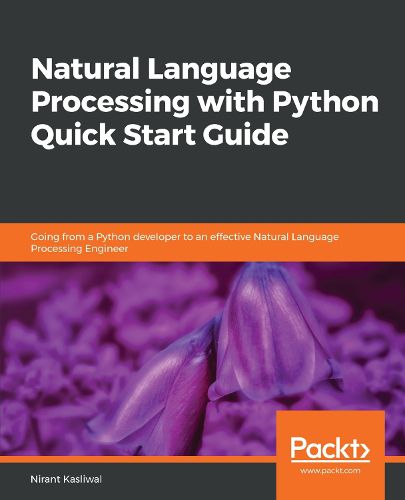Readings Newsletter
Become a Readings Member to make your shopping experience even easier.
Sign in or sign up for free!
You’re not far away from qualifying for FREE standard shipping within Australia
You’ve qualified for FREE standard shipping within Australia
The cart is loading…






This title is printed to order. This book may have been self-published. If so, we cannot guarantee the quality of the content. In the main most books will have gone through the editing process however some may not. We therefore suggest that you be aware of this before ordering this book. If in doubt check either the author or publisher’s details as we are unable to accept any returns unless they are faulty. Please contact us if you have any questions.
Build and deploy intelligent applications for natural language processing with Python by using industry standard tools and recently popular methods in deep learning
Key Features
A no-math, code-driven programmer’s guide to text processing and NLP Get state of the art results with modern tooling across linguistics, text vectors and machine learning Fundamentals of NLP methods from spaCy, gensim, scikit-learn and PyTorch
Book DescriptionNLP in Python is among the most sought after skills among data scientists. With code and relevant case studies, this book will show how you can use industry-grade tools to implement NLP programs capable of learning from relevant data. We will explore many modern methods ranging from spaCy to word vectors that have reinvented NLP.
The book takes you from the basics of NLP to building text processing applications. We start with an introduction to the basic vocabulary along with a workflow for building NLP applications.
We use industry-grade NLP tools for cleaning and pre-processing text, automatic question and answer generation using linguistics, text embedding, text classifier, and building a chatbot. With each project, you will learn a new concept of NLP. You will learn about entity recognition, part of speech tagging and dependency parsing for Q and A. We use text embedding for both clustering documents and making chatbots, and then build classifiers using scikit-learn.
We conclude by deploying these models as REST APIs with Flask.
By the end, you will be confident building NLP applications, and know exactly what to look for when approaching new challenges.
What you will learn
Understand classical linguistics in using English grammar for automatically generating questions and answers from a free text corpus Work with text embedding models for dense number representations of words, subwords and characters in the English language for exploring document clustering Deep Learning in NLP using PyTorch with a code-driven introduction to PyTorch Using an NLP project management Framework for estimating timelines and organizing your project into stages Hack and build a simple chatbot application in 30 minutes Deploy an NLP or machine learning application using Flask as RESTFUL APIs
Who this book is forProgrammers who wish to build systems that can interpret language. Exposure to Python programming is required. Familiarity with NLP or machine learning vocabulary will be helpful, but not mandatory.
$9.00 standard shipping within Australia
FREE standard shipping within Australia for orders over $100.00
Express & International shipping calculated at checkout
This title is printed to order. This book may have been self-published. If so, we cannot guarantee the quality of the content. In the main most books will have gone through the editing process however some may not. We therefore suggest that you be aware of this before ordering this book. If in doubt check either the author or publisher’s details as we are unable to accept any returns unless they are faulty. Please contact us if you have any questions.
Build and deploy intelligent applications for natural language processing with Python by using industry standard tools and recently popular methods in deep learning
Key Features
A no-math, code-driven programmer’s guide to text processing and NLP Get state of the art results with modern tooling across linguistics, text vectors and machine learning Fundamentals of NLP methods from spaCy, gensim, scikit-learn and PyTorch
Book DescriptionNLP in Python is among the most sought after skills among data scientists. With code and relevant case studies, this book will show how you can use industry-grade tools to implement NLP programs capable of learning from relevant data. We will explore many modern methods ranging from spaCy to word vectors that have reinvented NLP.
The book takes you from the basics of NLP to building text processing applications. We start with an introduction to the basic vocabulary along with a workflow for building NLP applications.
We use industry-grade NLP tools for cleaning and pre-processing text, automatic question and answer generation using linguistics, text embedding, text classifier, and building a chatbot. With each project, you will learn a new concept of NLP. You will learn about entity recognition, part of speech tagging and dependency parsing for Q and A. We use text embedding for both clustering documents and making chatbots, and then build classifiers using scikit-learn.
We conclude by deploying these models as REST APIs with Flask.
By the end, you will be confident building NLP applications, and know exactly what to look for when approaching new challenges.
What you will learn
Understand classical linguistics in using English grammar for automatically generating questions and answers from a free text corpus Work with text embedding models for dense number representations of words, subwords and characters in the English language for exploring document clustering Deep Learning in NLP using PyTorch with a code-driven introduction to PyTorch Using an NLP project management Framework for estimating timelines and organizing your project into stages Hack and build a simple chatbot application in 30 minutes Deploy an NLP or machine learning application using Flask as RESTFUL APIs
Who this book is forProgrammers who wish to build systems that can interpret language. Exposure to Python programming is required. Familiarity with NLP or machine learning vocabulary will be helpful, but not mandatory.